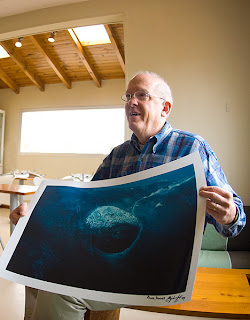 The biologist Roger Paine, a visionary of the whales conservation and sea worldwide, was in Puerto Piramides, he stayed at the Eco Lodge.
The biologist Roger Paine, a visionary of the whales conservation and sea worldwide, was in Puerto Piramides, he stayed at the Eco Lodge.This sensitive man who studied for 40 years right whales at Valdes Peninsula, was the first researcher and environmentalist in scientific studies on this species in the area.

Paine was spent in the beginning to the animal sound, began studying communication in bats, owls and moths, so that through a hydrophone (underwater microphone) was able to hear in 1965 long melodies, complex lyrics and are what now known as the humpback whale song. These songs are much more than those of birds extend to half an hour.Different whales interlacing strung these songs without a break, so that a session of singing can flow continuously for many hours. In the 60s and 70s this revolutionary contribution not only attracted the attention of the scientific community, but also the media.

In January 1979 the Journal of the National Geographic Society included a vinyl disc with recordings of humpback whale sounds made by Roger, selling 10 million copies of the magazine's subscribers.
In 1970, Valdes Peninsula, Patagonia Argentina, Roger discovered that he could be individually identified by photographs of the whales from the street patterns of the head. It was then that began the program of Southern Right Whale Research. Currently, this program is the study of longer duration in the world based on whale photo-identification.Until then, what was known about whales came mostly from the analysis of specimens hunted by the whaling industry. Dr. Payne discovered that following the lives of individuals, could learn much more about the whales of what was known from dead animals, as they can make population census, and specific information on various aspects of their behavior throughout their lives. This research carries on today in Valdes Peninsula, the Whale Conservation Institute (ICB).

In 1971 Dr Payne founded Whale Conservation Institute / Ocean Alliance (WCI / OA) in the U.S., still presides Institute. Recently conducted studies on board the sailboat Oddisey research to take skin samples from sperm whales and determine the levels of pollution of the seas of the world in an expedition that took more than five years.

His work has been featured over thirty documentaries for television, including the documentary made in 1991, which was nominated for Emmy Awards "In the company of whales". In 1995, Dr. Payne co-wrote and co-directed a production of IMAX, "Whales", which was very popular among the critics and the general public.An estimated audience of 40,000 people across the world sees that footage weekly. Dr. Payne always wanted to films and publications how can help, educate and raise awareness about the uncertain future of the planet.

In the hotel we give him the picture "SOS your destiny" by Alejandro Avampini, documentary photographer and owner of the Eco Friendly Hotel. This picture shocked years ago Roger Paine who believes that "It is the best photo of a whale's eyes have ever seen" ... and the proud photographer, can only boast of such a compliment!

Comments
Post a Comment